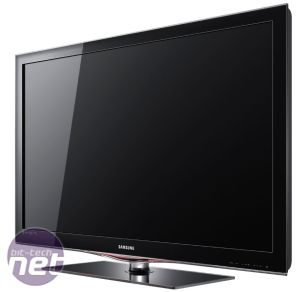
The Web TV experience
The range of internet services you can now get on a TV sounds very exciting, but how does it work in practice? We managed to get our hands on TVs from Samsung (the C650, pictured below) and Panasonic to check it out. The good news is that, with both the Viera Cast and Internet@TV services, the implementation is very good.In both cases there’s minimal setting up to do with an Ethernet connection, and only one long wait when you first use the Internet TV feature, to give the TV time to connect and download updates. The services themselves are well-designed for use from five to ten feet away with a remote control, with legible text, big buttons in simple grid-based layouts, and easy-to-find settings screens. The Viera Cast interface can look a bit boxy, but there’s no problem getting around it.
 And once you’ve started watching iPlayer or YouTube or viewing Picasa slideshows on a big HD screen, you won’t want to go back to the laptop or netbook. If iPlayer has always felt like a second-class TV experience on a notebook or desktop PC, it never feels like it on a TV screen. You can access HD streams, and the top-notch material looks stupendous. The same goes for HD material on YouTube, or Picasa photo galleries and slideshows. These services are just meant to be seen on a big screen.
And once you’ve started watching iPlayer or YouTube or viewing Picasa slideshows on a big HD screen, you won’t want to go back to the laptop or netbook. If iPlayer has always felt like a second-class TV experience on a notebook or desktop PC, it never feels like it on a TV screen. You can access HD streams, and the top-notch material looks stupendous. The same goes for HD material on YouTube, or Picasa photo galleries and slideshows. These services are just meant to be seen on a big screen.Movies on demand is another key strength. Even if Lovefilm’s movies are streamed in standard definition, quality-wise they remain watchable, and we were impressed at how effectively the buffering on the Samsung TV worked. After an initial delay while the TV filled up its onboard cache, we didn’t encounter any pauses or serious glitches during playback. Unfortunately, the service slowed down at peak periods, making it difficult to select a film, and while some content is free to users with Unlimited Lovefilm subscriptions (starting at £8.99 per month), the newer titles work on a pay-per-play basis, which seems a bit less of a bargain.
The biggest issue, as you might expect, is text entry. It’s no surprise that it’s a hassle with a remote control, despite the use of T9 and cursor-controlled onscreen keyboards, and we suspect that most of us wanting to access Facebook and Twitter on a TV screen want to do so to check other people’s tweets and updates rather than create our own. All the same, there’s no doubt that it’s slow going every time you have to input a username and password.

Panasonic's Viera Cast is not without its annoyances
Of the two services, Samsung’s Internet@TV takes the smarter approach to the problem. VieraCast will remember usernames and passwords if you want it to, but what do you do if you have multiple users for each service? Samsung uses a system of user profiles, where you sign in with a global username and four-digit password, then enter log-in details for Facebook, Picasa, Twitter et al which will be specific to that profile. Next time you use Internet@TV you merely need to login with the red button, choose the profile, enter the password, and hook up to Facebook and Picasa straight away.
Otherwise, the only real cause for complaint is that some services – notably Facebook and Picasa – don’t feel as snappy or responsive as they do on a notebook or desktop PC. Given the limited processing power and memory onboard TVs this shouldn’t come as any great surprise, and we’re not talking about anything disastrous.

MSI MPG Velox 100R Chassis Review
October 14 2021 | 15:04








Want to comment? Please log in.